Chicago芝加哥
Chicago
“I have struck a city, and they call it Chicago. Having seen it I urgently desire never to see it again.” That was the reaction of English writer Rudyard Kipling, when he visited Chicago for the first time.
Before World War II Chicago, standing at the southern end of vast Lake Michigan, had the reputation of being one of the toughest, most lawless and corrupt cities in the world. It earned its evil reputation largely from the gang warfare promoted by the most notorious gangster of all time, Al Capone. Al Capone flourished on selling illegal liquor during the days of Prohibition (1919-1933), when a federal law forbade Americans to make or sell alcohol in any form.
Chicagoans have a great pride in their city. They boast that it is of greater importance to the nation than New York. It is the center of American commerce and transportation. O’Hare Airport is the busiest airport in the world. 44 million passengers pass through it every year, and there are 2,000 take-offs and landings every day. Chicago is still the center of the American railroad system.
Chicago is also a great inland port, unique in the world. It can send goods by ocean-going ships all the way to Europe—via the Great Lakes and the Saint Lawrence Seaway. It can send goods by barge, through waterways and canals, to the Mississippi and down it to the Gulf of Mexico.
Chicago makes steel and refines oil, but it also stands on the edge of the Great Plains. So the cereals and the beef from the prairies pass through the city. From the 1830s to the 1960s Chicago was one of the great meat-packing centers of the USA. The smell of its stockyards and slaughterhouses once pervaded the whole city.
Chicago disproves the melting-pot theory of American society. Among its population of 3.1 million there are over 1 million blacks, as well as Hispanics, Irish, Poles, Jews, Russians, Swedes, American Indians, Chinese and Japanese, more or less in that order. There are some mixed neighborhoods, but for the most part the different ethnic groups still live apart, and still celebrate in the streets of the city their own special festivities. Yet the city has a powerful personality of its own which is very American. Since Chicago built the first tallest skyscraper, and it now has more other skyscrapers. Much of its downtown architecture is magnificent, and very original. But Chicago’s chief glory is it 29-mile Lake Front. It is laid out with beautiful parks. It is the neighborhood of the museums and of the luxurious homes of Chicago’s rich.
A few years ago, Lake Michigan was so polluted that no one would swim in it, and the water was discolored. Most of the fish had died. Now both the lake and the sky are clear. Pollution has been conquered, though the people of Chicago are still not completely satisfied. The rise and fall of Chicago’s pollution is a good example of the speed with which Americans create problems—and then solve them.
芝加哥
“我到过一个城市,人们叫它芝加哥。在我见到它的那一时刻,我就迫切地希望我再永远
也不见到它了。”这是英国作家拉迪亚德·吉卜林在第一次游历芝加哥时的感受。
芝加哥位于宽袤的密歇根湖南端。二战之前,芝加哥就臭名远扬,是世界上最为横暴、最为为非作歹、最为腐败的城市之一。芝加哥坏名声的得来主要是因为这时有最为臭名昭著的阿尔· 凯彭匪徒的帮派争斗存在。阿尔· 凯彭的发迹靠的是他们在美国禁酒令(1919-1933)期间进行销售酒精饮料的违法勾当。那个期间联邦法律是禁止任何人以任何方式制造和销售酒精饮料的。
如今,芝加哥人都为自己的城市而感到自豪了。他们夸口说,就整个国家而言,芝加哥比纽约更为重要。它是美国的商贸和交通中心。欧· 黑尔机场是世界上最为繁忙的机场。这里每年有四千四百万乘客路过,飞机的起降每天达两千架次。芝加哥也是美国的公路运输中心。
芝加哥同时还是一个极大的内陆港,这在世界上是很独特的。通过五大湖和圣劳伦斯航道,从这里可以用远洋货轮运载货物到欧洲。通过水路和运河,也可以从这里用驳船将货物运到密西西比河直到墨西哥湾。
芝加哥的工业是钢铁生产和石油精练。同时,由于它地处大平原的边缘,所以谷类的农产品和来自大草原的牛肉也进入了城市。从十九世纪三十年代到二十世纪六十年代,芝加哥就是美国的肉食品包装中心之一,一段时间,整个城市里到处都可以看到牲畜围栏和屠宰场。 芝加哥否定了美国社会的熔炉理论之说。在三百一十万人口中,有一百多万是黑人。然后按照大概的顺序是西班牙人、爱尔兰人、波兰人、犹太人、俄罗斯人、瑞士人、美国印地安人、中国人和日本人。虽然这里也有杂居的人群,但大部分还是按民族的不同而异地居住,因而,他们各自在街道上庆祝的还是自己的独特民族节日。
然而,芝加哥仍然有着它极强的美国特性。它是世界上第一个建造最高的摩天大楼的城市,而且现在又有其它的摩天大楼。它的城市建筑风格显得极为壮观且有独创性。但最让芝加哥人事感到骄傲的是那29英里长的湖滨地带。它以公园的形式展现于人们眼前,十分美丽。在它旁边的是博物馆和芝加哥富人们居住的豪华住宅。
几年前,密歇根湖的污染还很严重,没有人愿意在里面游泳。湖水变了颜色,大部分的鱼都死掉了。而现在,湖水和天空清净了,污染被控制住了。当然芝加哥人对此还不十分满意。芝加哥人口数量的涨落就是美国人制造问题、然后解决问题之速度的一个例证。
选 译:杨 武 地址:湖北麻城市教育局教研室
邮 编:438300 电话:0713-2917455 (0)135xxxxxxxx
E-mail: //
第二篇:19xx在大都市芝加哥的集会调查(Survey of Congregations in Metropolitan Chicago, 19xx)_数据挖掘_科研数
1994在大都市芝加哥的集会调查(Survey of Congregations in Metropolitan Chicago, 1994)
数据介绍:
The Religion in Urban America Program (RUAP) conducts research in metropolitan Chicago concerning the diverse ways religious
organizations of all faiths serve urban people and address urban issues. The heart of the study is an empirical examination of religious and religiously affiliated organizations in metropolitan Chicago. We have conducted case studies of some 75 congregations and numerous other organizations--denominational, ecumenical, and interfaith agencies, religiously based community organizations, and special-purpose groups. Using ethnography as the principal research method, which includes on-site observations and interviews, we attempt to understand and interpret each organization on its own terms and with attention to those features and purposes considered most important by its leaders and constituencies. The Survey of Congregations in Metropolitan Chicago was conducted for the sole purpose of providing information to assist us in selecting congregations to serve as ethno
关键词:
集会调查,大城市芝加哥,宗教团体,实证检验,附属机构, survey of
congregation,metropolitan Chicago,religious organization,empirical examination,affiliated organizations,
数据格式:
TEXT
数据详细介绍: Survey of Congregations in Metropolitan Chicago, 1994
The Religion in Urban America Program (RUAP) conducts research in
metropolitan Chicago concerning the diverse ways religious organizations of all faiths serve urban people and address urban issues. The heart of the study is an empirical examination of religious and religiously affiliated organizations in metropolitan Chicago. We have conducted case studies of some 75 congregations and numerous other organizations--denominational, ecumenical, and interfaith agencies, religiously based community
organizations, and special-purpose groups. Using ethnography as the principal research method, which includes on-site observations and interviews, we attempt to understand and interpret each organization on its own terms and with attention to those features and purposes considered most important by its leaders and constituencies. The Survey of Congregations in Metropolitan Chicago was conducted for the sole purpose of providing information to assist us in selecting congregations to serve as ethnographic case studies. Data File
Cases: 218
Variables: 65
Weight Variable: None Data Collection
Date Collected: Data were collected on the size, membership characteristics, programs, and other features of congregations located in seven selected neighborhoods in metropolitan Chicago, plus a section of suburban DuPage County. Please note that our only purpose in collecting these data was to provide a partial basis for selecting congregations to serve as case studies in a largely ethnographic research project. We did not anticipate their use for quantitative analysis or their treatment as a single data set. The data on congregations were
collected between September 1, 1992, and December 31, 1994, and were current information at the times collected. All the congregations of each particular neighborhood were surveyed together. The demographic data on the neighborhoods in which the congregations were located were taken in 1995 from the 1990 U.S. Census. Funded By
Lilly Endowment, Inc.
Park Ridge Center of Health, Faith, and Ethics Collection Procedures
The congregation data were obtained through a self-administered survey that we mailed to respondents with a self-addressed return envelope. There were small variations in the questionnaires administered in the different neighborhoods (changed as we learned what information was most useful to us), so not all questions were asked in all neighborhoods. We attempted to contact all non-respondents by phone, and took responses by phone and recorded them on the questionnaires. Sampling Procedures
The population was composed of all the religious congregations we could identify in the selected neighborhoods. Each "neighborhood" was defined for our research purposes as a Chicago "Community Area" or combination of "Community Areas" or a combination of specified suburban municipalities. "Community Area" is a sub-municipal designation unique to Chicago for which U.S. Census data are readily available.
By reference to the "Commarea" (Community Area) field in the data set, these "neighborhoods" were defined by RUAP. Please note that the neighborhood names are close to, but not always identical with, the official names of community areas, and should not be confused with each other. The assigned definitions are as follows:
"Rogers Park": Commarea 1 and 2
"Loop/Near North": Commarea 8 and 32
"Chatham": Commarea 44 and 69
"West Side": Commarea 26, 27, and 28
"Pilsen": Commarea 30 and 31
"Southwest Side": Commarea 62, 63, 65, and 66. (There is also one congregation in Community Area 61 and one congregation in Community Area 68. However, these are immediately adjacent to one of the four community areas and are treated as part of the Southwest Side neighborhood without including the demographic information of the
community areas in which they are technically located.)
"Southern DuPage County": This "neighborhood" included the suburban municipalities of Bolingbrook, Burr Ridge, Clarendon Hills, Darien, Downers Grove, Hinsdale, Lemont, Lisle, Naperville, Oak Brook, Westmont, Woodridge.
We initially listed these congregations by combining listings from telephone Yellow Pages, denominational directories, and all other religious directories available. Then we conducted a "windshield survey," driving through all the streets within the boundaries of the neighborhood and added to, deleted from or corrected the lists we had assembled from directories.
We sent the survey to every congregation we identified. The response varied widely from neighborhood to neighborhood. The following table shows the neighborhoods in which we conducted research, the community areas and municipalities from which these neighborhoods were taken, the number of congregations identified in each neighborhood, and the number of responses in each neighborhood. Principal Investigators
Dr. Lowell W. Livezey, Director and Principal Investigator
Religion in Urban America Program
University of Illinois at Chicago
Dr. Elfriede Wedam, Associate Director and Research Associate
Research Associate, Religion in Urban Culture Project, The Polis Center, IUPUI
Dr. Paul D. Numrich, Research Associate
Research Assistant Professor
Office of Social Science Research
University of Illinois at Chicago
Dr. David D. Daniels, Research Associate
Associate Professor of Church History
McCormick Theological Seminary
Dr. Larry G. Murphy, Research Associate
Associate Professor of Church History
Garrett-Evangelical Theological Seminary
Dr. Matthew J. Price, Research Associate
Lecturer, Duke University Divinity School
Dr. Peter R. D'Agostino, Research Associate
Assistant Professor of Religion
Stonehill College
Ms. Janise Hurtig, Research Associate
Post doctoral Fellow
University of Illinois at Chicago
Dr. William Peterman, Research Associate
Professor of Geography
Chicago State University Related Publications
Lowell W. Livezey, ed., (1996) Religious
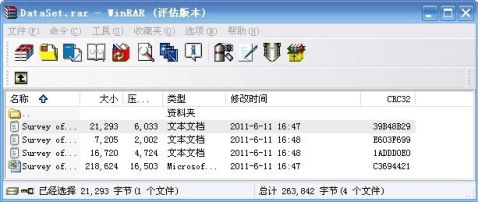
Organizations and Structural Change in Metropolitan Chicago: The Research Report of the Religion in Urban America Program. Chicago: University of Illinois at Chicago, 1996.
数据预览:
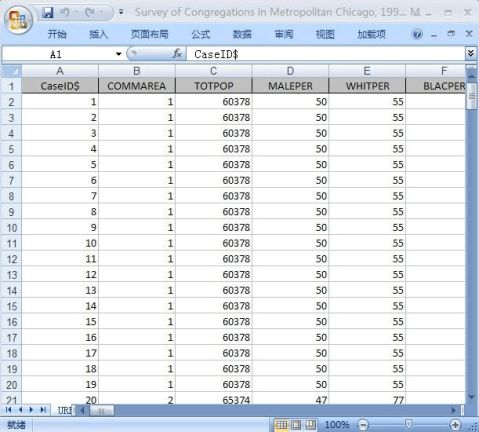
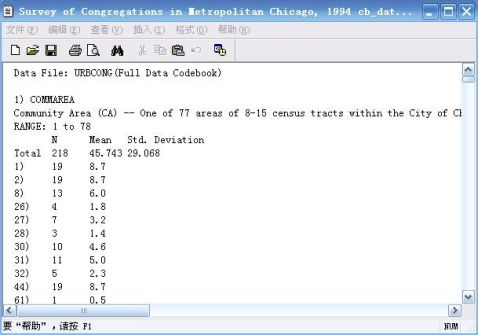
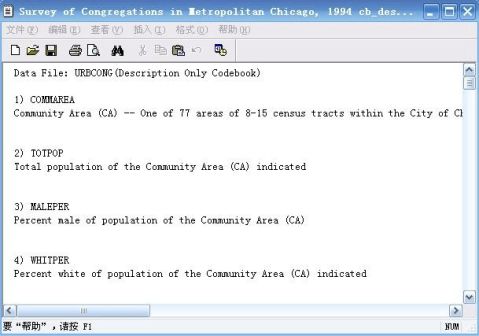
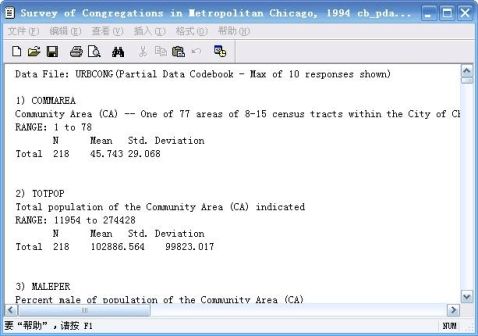
点此下载完整数据集
-
Coco Chanel名言
1Agirlshouldbetwothingsclassyandfabulous每个女孩都该做到两点有品位并且光芒四射2Inord…
- Coco Chanel的20句人生名言
-
Coco Chanel的20句名言中法文对照
CocoChanel的20句名言中法文对照20xx0916161400来源中国日报作者CocoChanel是二十年代的时装女王她超…
-
香奈儿创始人Coco Chanel经典英语名言
香奈儿创始人CocoChanel经典英语名言中英对照Chanel品牌的创办人CocoChanel原名GabrielleBonheu…
-
香奈儿创始人Coco Chanel经典英语名言
香奈儿创始人CocoChanel经典英语名言Agirlshouldbetwothingsclassyandfabulous每个女孩…
-
申请书格式
台头:关于xxxxx的申请正文:xxxxx:兹有xxxxx因xxxx需向xxxx申请办理xxxxxx事宜。特此申请。申请单位:(申…
-
通知 格式及范文
通知的格式及范文通知的格式包括标题、称呼、正文、落款。①标题:写在第一行正中。可只写“通知”二字,如果事情重要或紧急,也可写“重…
-
函的格式范文
函的格式范文函的分类函可以从不同角度分类一按性质分可以分为公函和便函两种公函用于机关单位正式的公务活动往来便函则用于日常事务性工作…
-
通讯格式范文
通讯的概念1通讯是运用叙述描写抒情议论等多种手法具体生动形象地反映新闻事件或典型人物的一种新闻报道形式它是记叙文的一种是报纸广播电…
-
文档排版格式要求及范文
文档排版格式初级要求及范文为了统一大家所做迎检材料的排版格式现将简单的排版格式给大家说一下字体由刘生华同学来给你们安装红色字体为掌…